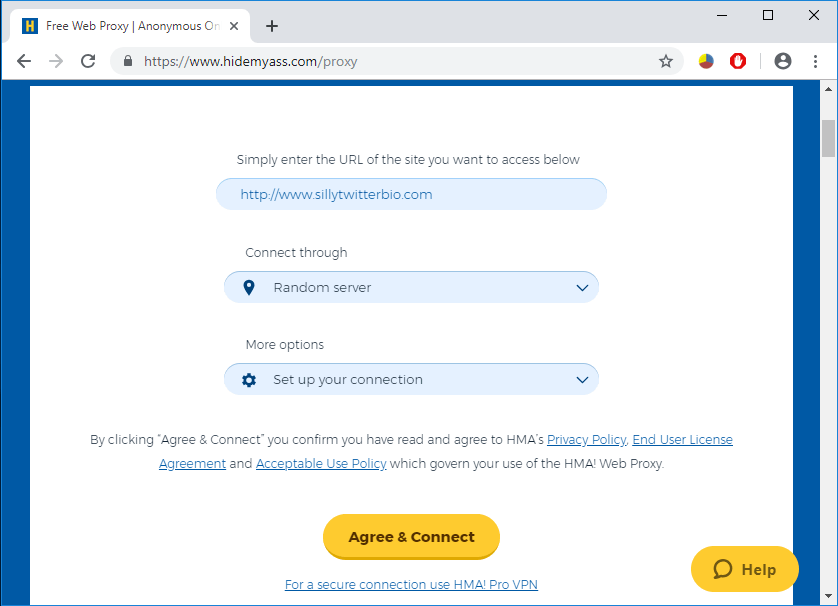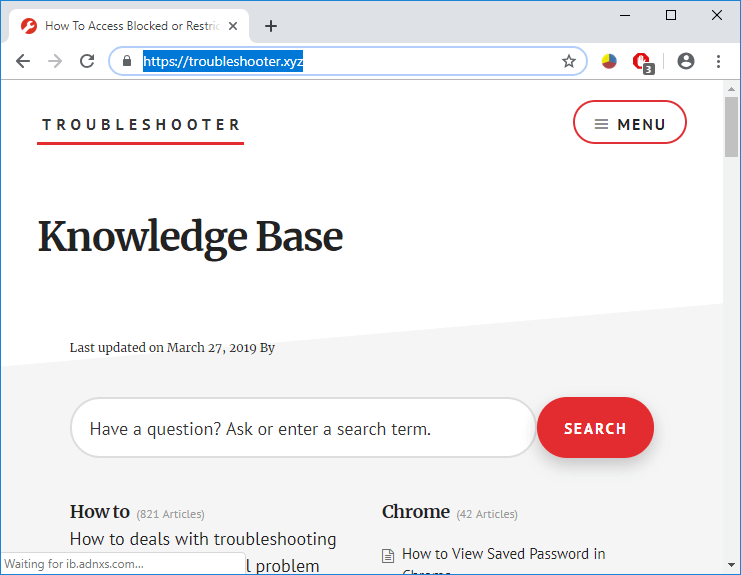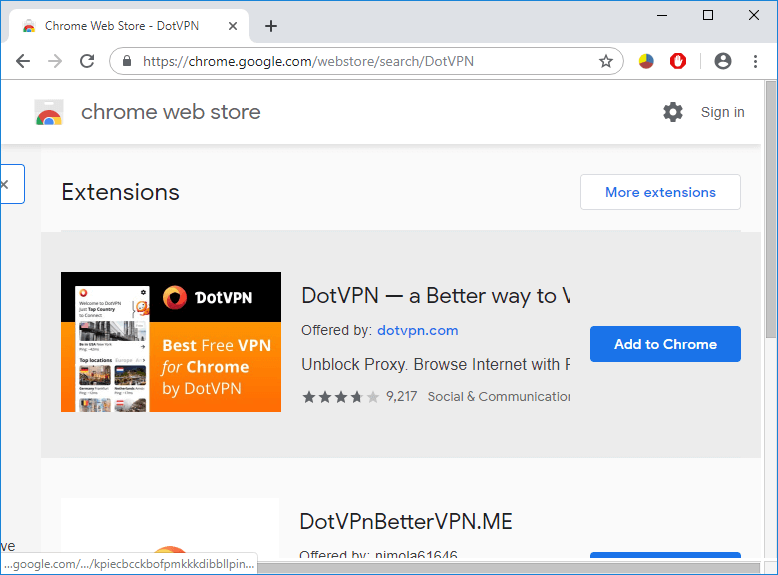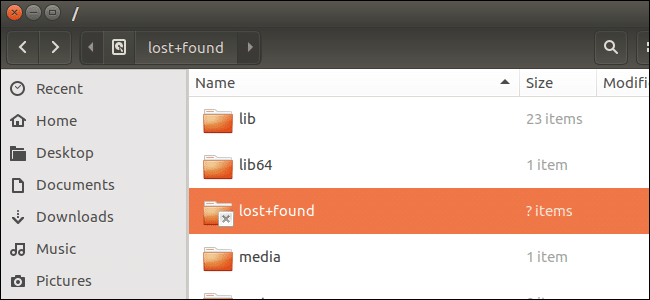Access Blocked Websites: Are your favorite sites blocked on your college Wi-Fi? Or is it something on your computer that doesn’t let you get to it? There could be plenty of reasons why you can’t access a particular website. It could be blocked on your computer or on your network or in fact, completely banned in your country. This article will take you through a number of methods that can help you unblock these blocked websites on Windows 10. Let’s start.

Access Blocked or Restricted Websites for Free
If you are unable to open a particular website, try these:
Is The Website Down?
It is possible that the website you want to open is not actually blocked but instead it is down due to some website issue. To check if some website is down or if it is working, you can use website monitors like DownForEveryoneOrJustMe.com or isitdownrightnow.com and enter the URL of the website you want to check.
Blocked or Restricted Websites? Here is How to Access them for free
Method 1: Use VPN for Unblocking
A virtual proxy network allows you to access any blocked websites by creating a tunnel between your computer and a VPN server, making it difficult for websites to trace your identity or any other data by encrypting entire computer traffic. Hence, your IP address is anonymized and you can access the blocked website from anywhere in the world. You can use VPN services like ExpressVPN, Hotspot Shield etc. These VPNs allow you to choose a country of your choice which will be used as your fake location, which allows you to use the location-based sites and services.

Method 2: Use a Proxy To Access Restricted Websites
Proxy servers, unlike VPNs, only hide your IP address. They do not encrypt your traffic but only cut away any identification that your communications might contain. It is less secure than VPNs but it works well on school or institutional level. There are many proxy websites that allow you to access any blocked websites. Some of the proxy websites that you can use are Newipnow.com, Hidemyass.com, Proxy.my-addr.com.
Method 3: Use the IP Address instead of URL
The URLs that we use to access a website are just the hostnames of websites and not their actual address. These hostnames are used to first map to their actual IP address and then the connection is made. However, it is possible that only the URL of the website is blocked. In such a case, accessing the website via its IP address will be sufficient. To find the IP address of any website,
- Click on the search field located beside the windows button.
- Type cmd.
- Use the shortcut to open the command prompt.
- In the command prompt, type “ping www.websitename.com”. Note: Replace “www.websitename.com” with the actual website address.
- You will get the required IP address.

Use this IP address to enter directly into your web browser and you will be able to access blocked or restricted websites.
Method 4: Use Google Translate
You can unblock certain websites using Google Translate. This method works because instead of accessing the website through your local network, you are now rerouting it through Google. Google Translate is almost never blocked as it is considered to be of educational purposes. In order to use Google Translate for such purpose,
- Open Google Translate.
- Change the ‘from’ language to some language other than English.
- Change the ‘to’ language to English.
- Now in the source box, type the URL of the website you need.
- Translated version will now give you a clickable link of your desired website.
- Click on the link and you will be able to access the blocked websites for free.
Note that this method does not work for websites blocked by your ISP (Internet Service Provider) itself.
Method 5: URL Recasting Method
This method works for those websites which are hosted on a VPS (Virtual Private Server). Some websites are blocked because the SSL certificate of that domain is not installed. So, instead of using www.yourwebsite.com or http://yourwebsite.com, try writing https://yourwebsite.com on your web browser. Click on Proceed Anyway if a security warning arises and you will be able to visit the “access denied” website.
Method 6: Replace your DNS Server (Use a Different DNS)
DNS server maps the website’s URL or hostname to its IP address. In case of blocked websites, it is possible that the concerned authorities or institutions have blocked the websites on their own DNS. In such cases, substituting your DNS with a public DNS will allow you to access blocked websites. Using GoogleDNS or OpenDNS will probably solve your problem. To do this,
- Click on the Wi-Fi icon on the taskbar and go to ‘Network & Internet settings’.
- Select WiFi then click on ‘Change adapter options’.
- Right-click on your internet connection (WiFi) and select properties.
- Select Internet Protocol Version 4 (TCP/IPv4) and click on properties.
- Checkmark ‘Use the following DNS server addresses’ radio button.
- Type 8.8.8.8 in the preferred DNS text box and 8.8.4.4 in the alternate DNS text box.
- Click on confirm to Apply the changes.

Method 7: Bypass Censorship via Extensions
A website could be of any of the two types- static or dynamic. This method will work if the website you are trying to access is dynamic. Try accessing websites like YouTube or Facebook through extensions. DotVPN, UltraSurf, and ZenMate are a few awesome extensions that you should check out in order to access any blocked website for free without any restriction. On Chrome, to add extensions,

- Open a New Tab and click on Apps.
- Open Web Store and search for any extension you want to add.
- Click on Add to Chrome.
- You can enable or disable any extension by going to More tools > Extensions in the three-dot menu on the upper right corner of the browser window.
Method 8: Use A Portable Proxy Browser
In cases where you are not even allowed to add extensions on the web browser, you can use a portable web browser which can be installed on your USB drive and also reroutes all the internet traffic through a proxy address. For this, you can directly use KProxy browser which removes all restrictions on websites. You can also install a web browser like Firefox portable and add a proxy IP address in its proxy configurations to access any blocked or restricted websites.

These methods will let you access any websites at any time and from anywhere in the world without any restrictions.
I hope this article was helpful and you can now easily Access Blocked or Restricted Websites, but if you still have any questions regarding this guide then feel free to ask them in the comment’s section.






